Updated September 19, 2023 at 6:40 pm: According to the Financial and Major Projects Update on the TTC Board agenda for September 26, 2023:
Detailed Design Review (100%) for the Spadina Station – Streetcar Platform Extension is underway and expected to be completed by Q3 2023.
Nearby redevelopment planned to occur in the near future will provide access to the tunnel structure for platform expansion.
Regular riders of the 510 Spadina will be familiar with long, sometimes very long, intervals spent waiting in the tunnel outside of Spadina Station just for their car to move onto the platform and discharge passengers.
This is the compound effect of several factors:
- The Flexity streetcars are too long for two of them to be on the platform at once (as the former CLRV cars could be) with one loading and the other unloading.
- The Flexitys cannot selectively open doors, except for the very front one, to serve riders while only partly on the platform.
- A common situation at this station is for a car to wait on the platform while the operator takes a bathroom break or waits for a relief crew to show up.
- The running times on the 510 schedule are generous enough that there is usually time to sit at Spadina Station rather than leaving immediately.
- During some periods, service that would normally operate to Union Station is cut back to Queens Quay or Charlotte Loop giving cars even more surplus running time.
- When service on Spadina is bunched and a parade of cars reaches Spadina Station, only one car can use the platform while those behind wait in the tunnel.
This situation cries out for better line management and scheduling, including shifting away from a strict adherence to “on time” cars and a move to dispatching on a regular headway to avoid backlogs. Step back crews would be essential in allowing cars to leave as quickly as possible while operators had their breaks. (Note that breaks are generally not taken at Union because it is a busy station serving two routes.)
As things are, much of the benefit for riders of a reserved lane on Spadina can be undone by the operation at Spadina Station.
During the month of August 2023, 510 Spadina service to Union did not operate on the following days so that all service at Union could be provided by 509 Harbourfront cars to Exhibition Loop:
- Saturday, August 5 from about 8am to 8pm during the Caribbean Carnival.
- Friday, August 18 onward from about 10am to 8pm during the CNE.
In an attempt to see just how bad this problem was, I built a fine-grained “map” of Spadina Station Loop for my usual route analysis programs. This includes screenlines at:
- The loop entrance where the north and southbound tracks divide
- The east end of the station platform
- The west end of the station platform
This allows plotting of how long cars spent queued in the tunnel, and how long they sat on the platform. Unfortunately, it is not possible to resolve the difference between cars sitting at the loading area at the west end of the platform and those almost, but not quite, on the platform to unload.
(The reason for this is that the TTC’s “Vision” tracking system does not accurately map car positions inside the station. Indeed, cars sometimes appear to reverse within the station according to the GPS data. This is likely due to the problem of getting accurate GPS info underground.)
This is a route that should have more reliable service given its operation entirely in reserved lanes, and it certainly should not make riders wait five minutes or more just for a car to reach the platform at Spadina Station.
The TTC’s Real Estate Investment Plan includes an item for expansion of the platform at Spadina Station, but it is not clear that this applies to the streetcar platform. With the current tight budget it is hard to see this sitting near the top of the pile for funding.
Scheduled Service
Here is the summary of scheduled service on 510 Spadina in August 2023. What is particularly striking here is the very long terminal time allowances during many periods exceeding the capacity of terminals to hold vehicles.

How Long Do Cars Sit on the Platform?
The charts in this section show the time spent somewhere on the platform at Spadina Station. The first chart shows weekday averages and standard deviations of the headways. The remaining charts show details by day for each week, and for Saturdays and Sunday/Holidays.
The values are fairly consistent throughout, although they are spread over a range up to ten minutes. With a scheduled service of 5 minutes or less during most periods, cars cannot sit on the platform for long without creating a backlog.
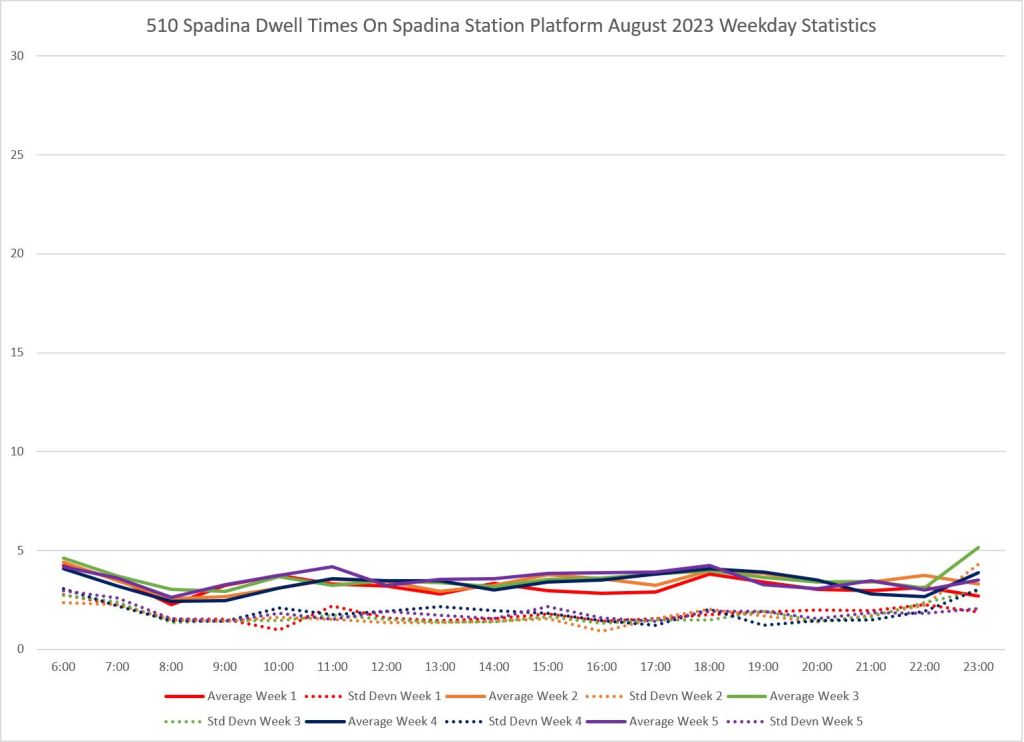
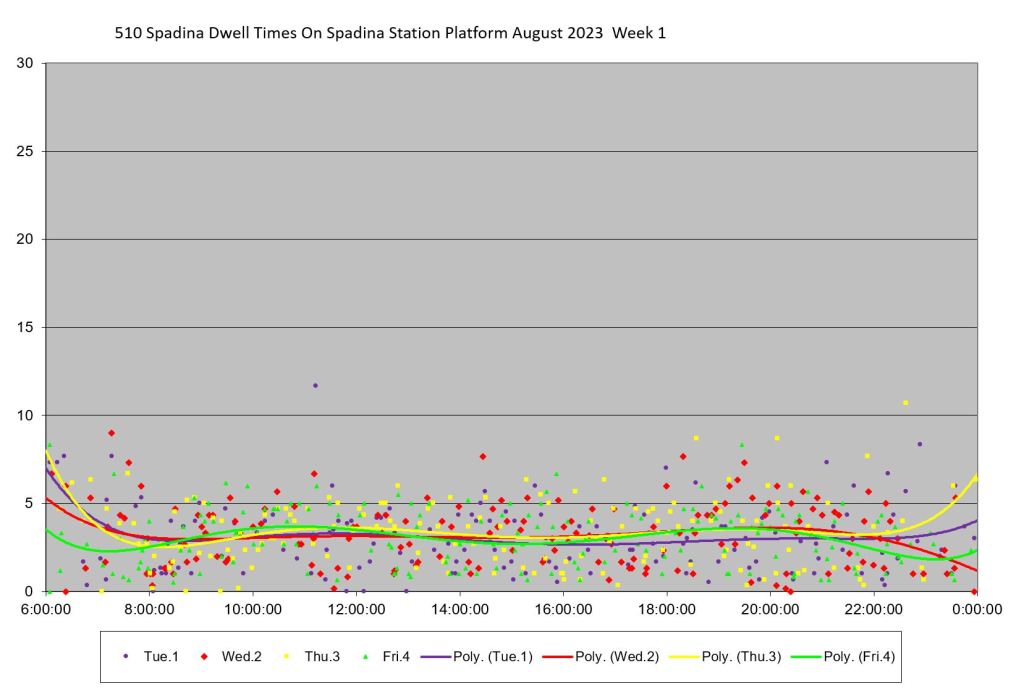
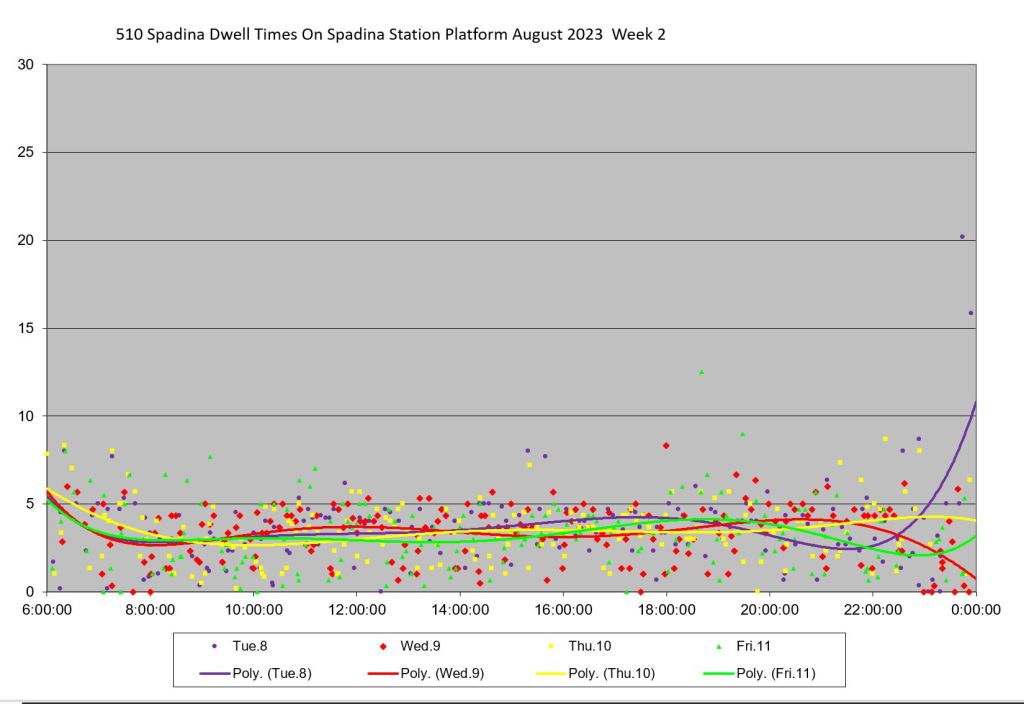
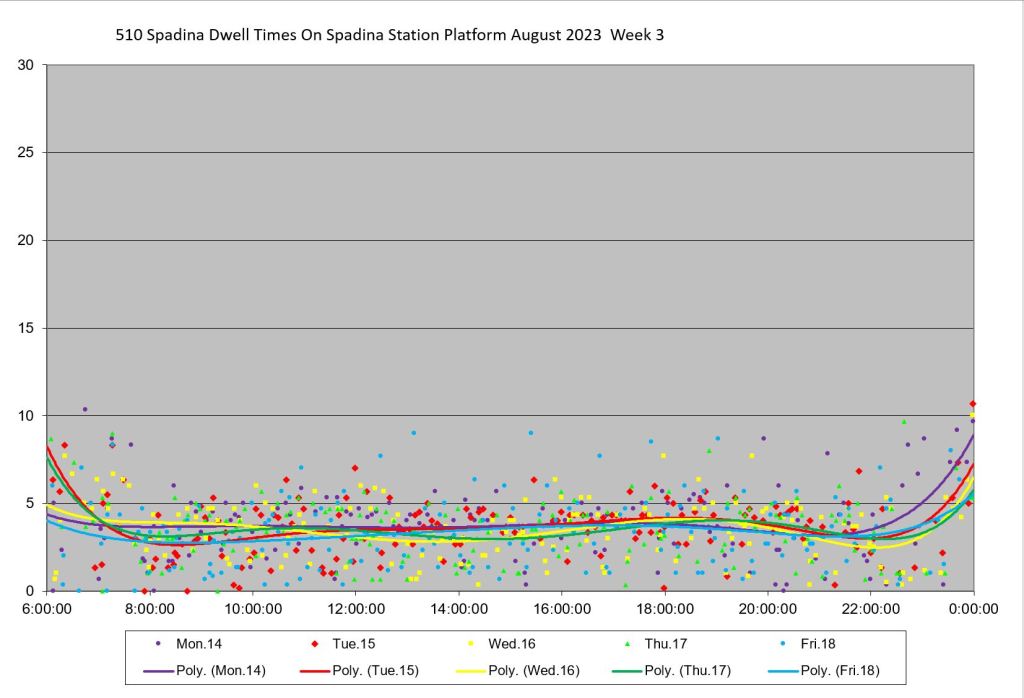
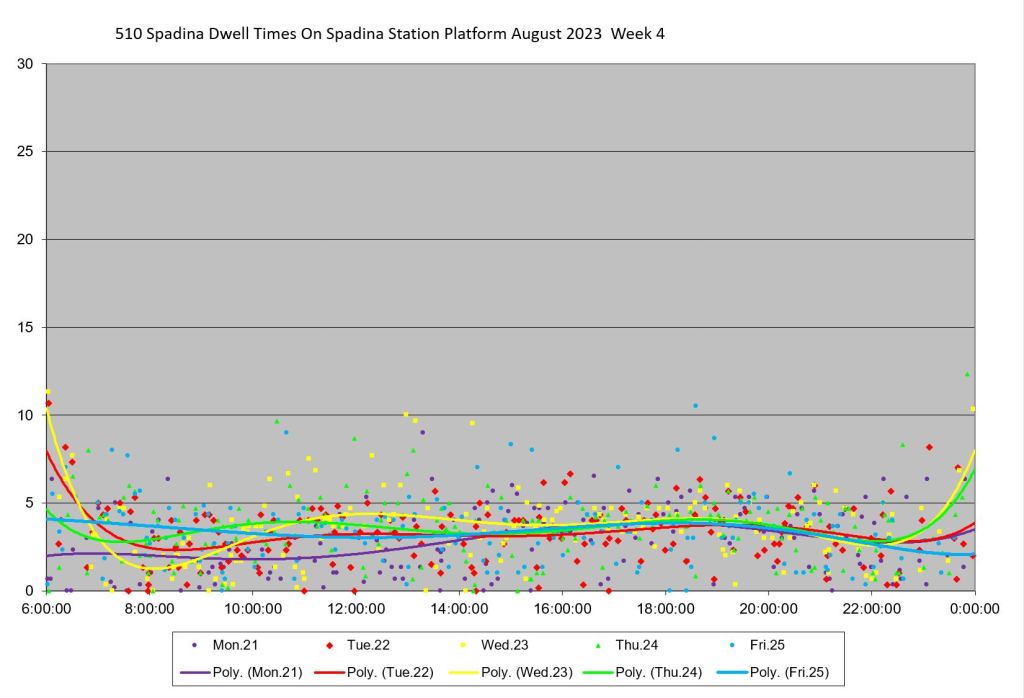
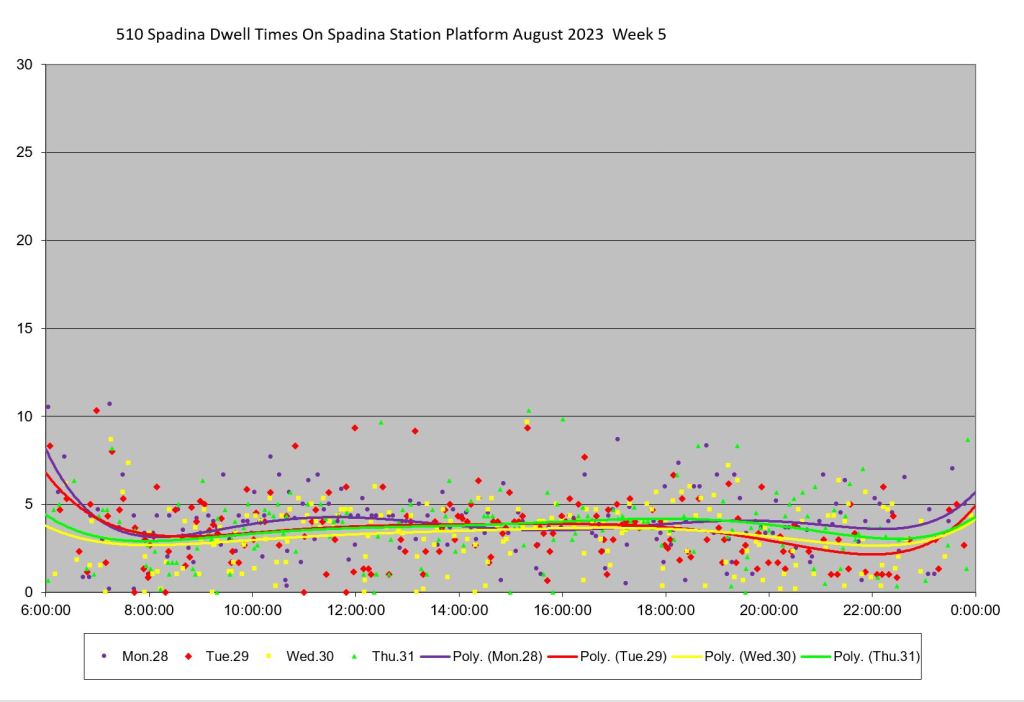
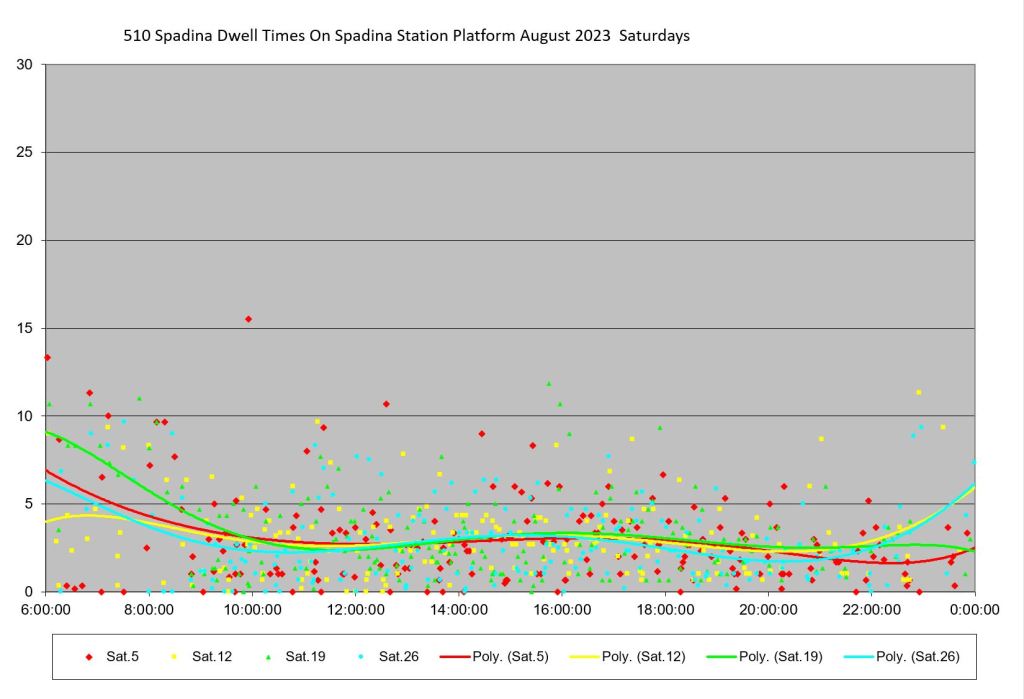
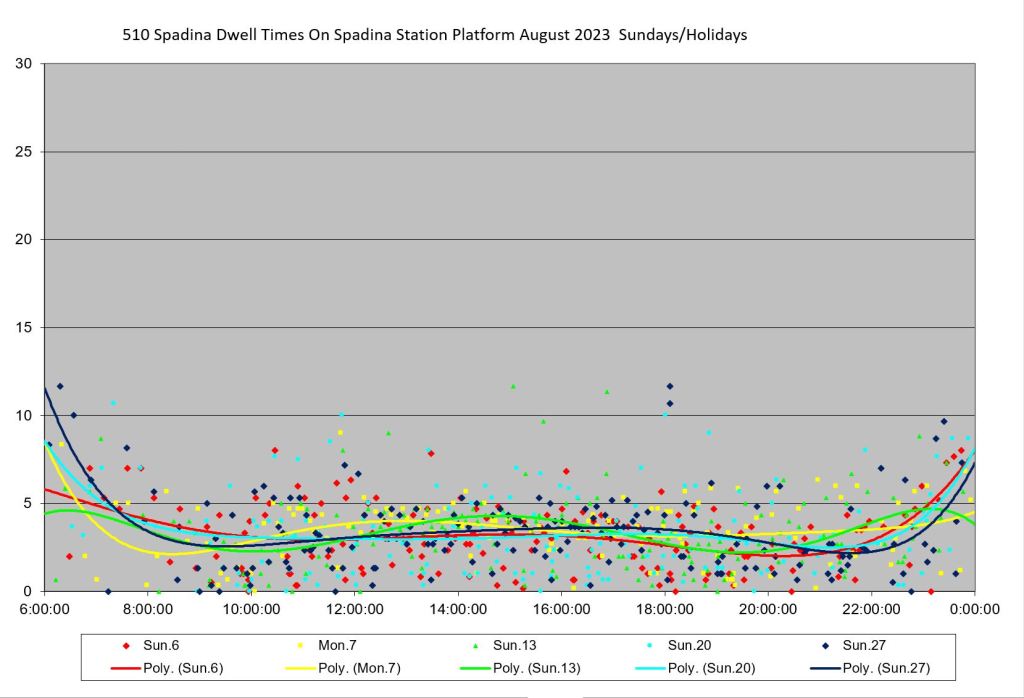
How Long Do Cars Wait On The Approach
It is common for cars to sit in the tunnel approaching the station because there is no room on the platform. Note that the times here do not include time spent almost on the platform waiting to move up and discharge passengers. Various effects are clear here:
- In Week 3, Friday (the first day of the CNE service configuration), the trend line (turquoise) sits higher than the other days, and many data points sit outside of the main “cloud” of values above the 5 minute line.
- The weekly averages run slightly higher for Weeks 4 and 5 (CNE) than for the earlier part of the month. The individual values for these weeks also run higher than early in the month.
- Saturdays are particularly bad with some cars waiting over 10 minutes just to reach the platform, notably on August 5.
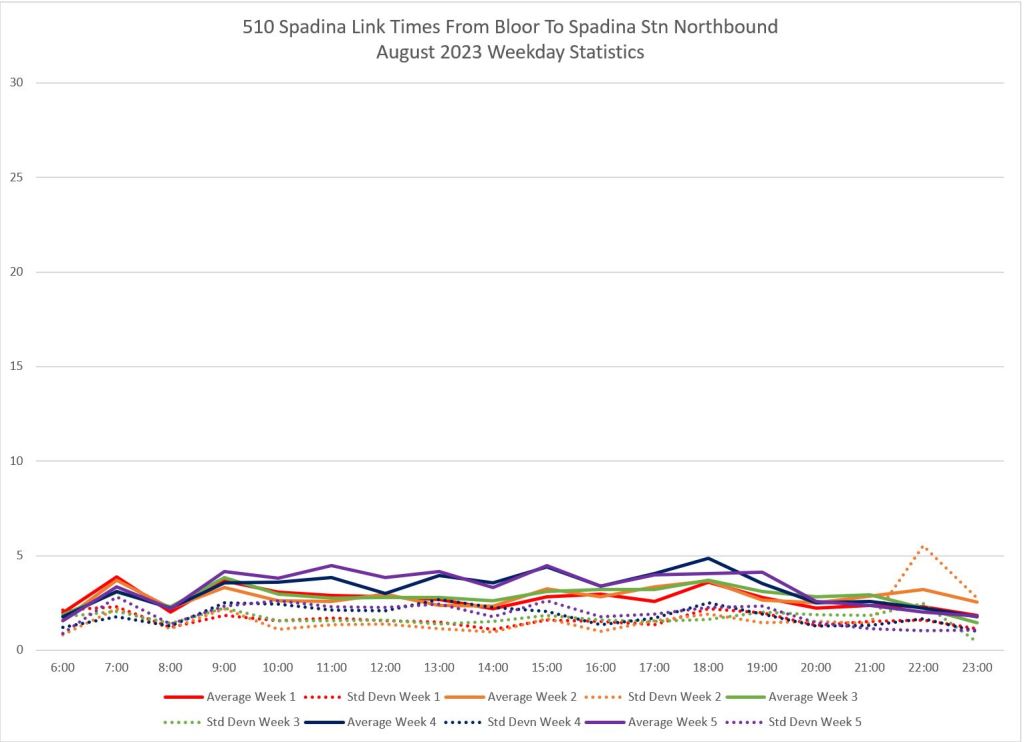
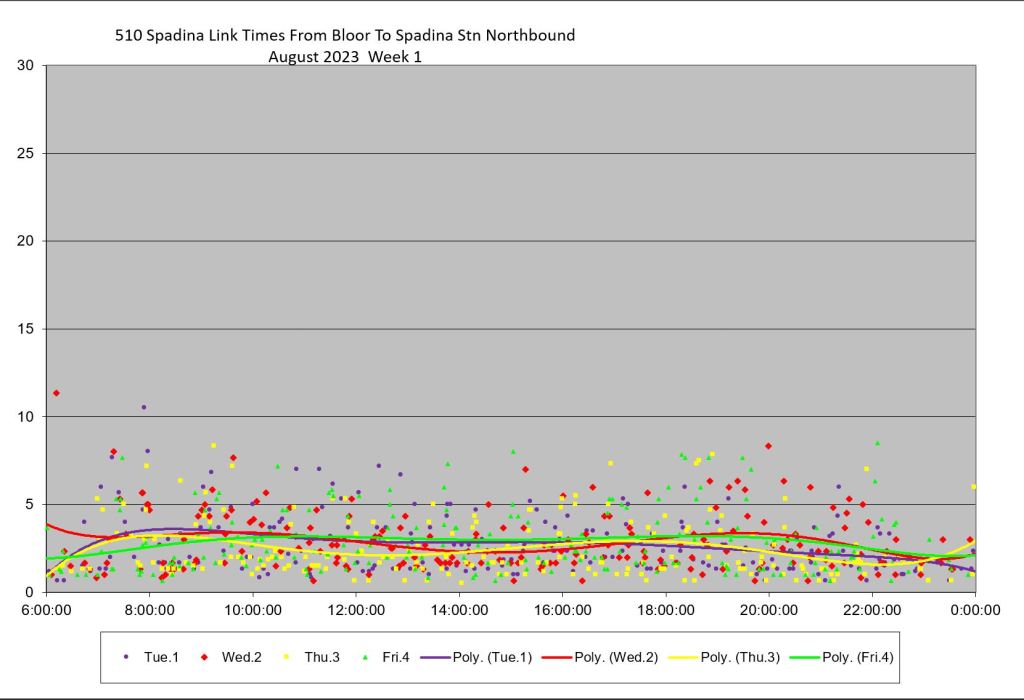
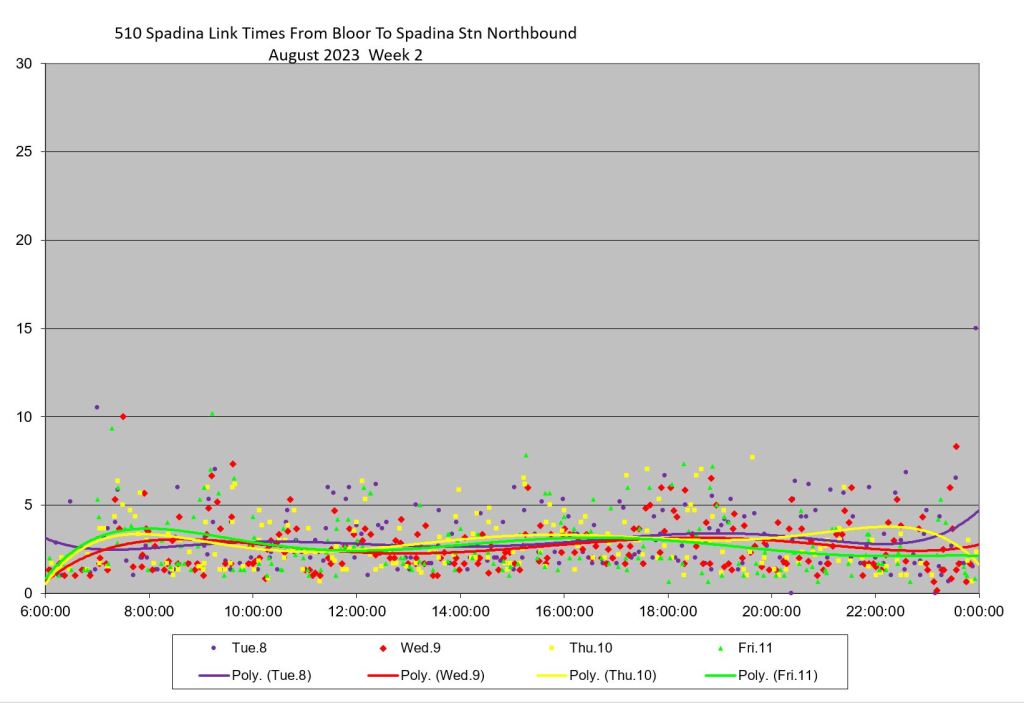
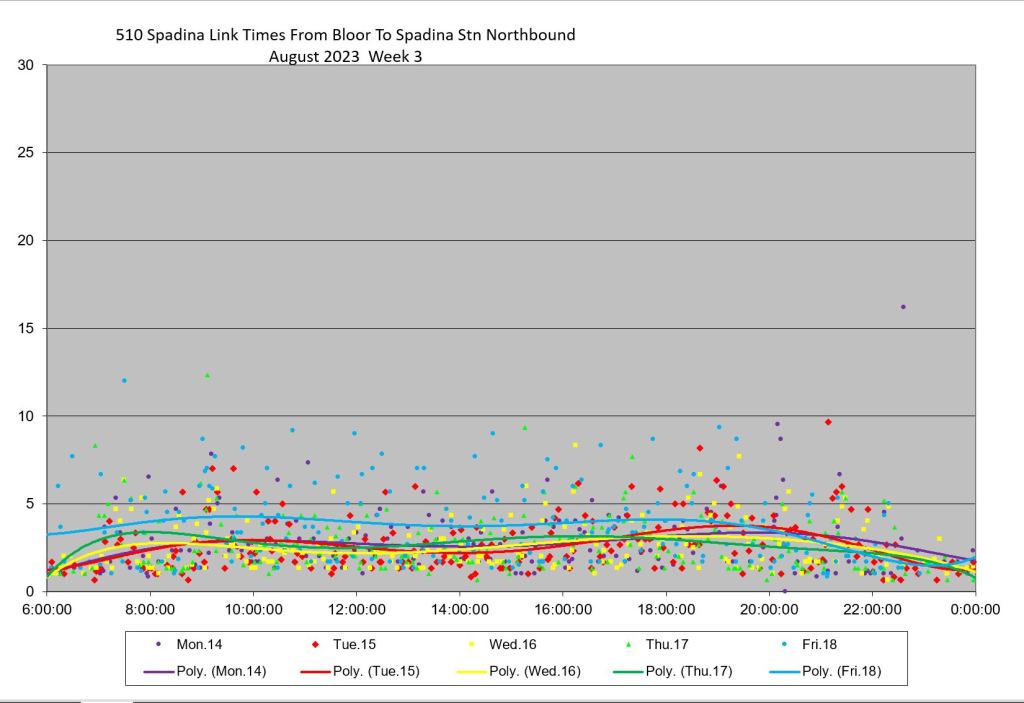
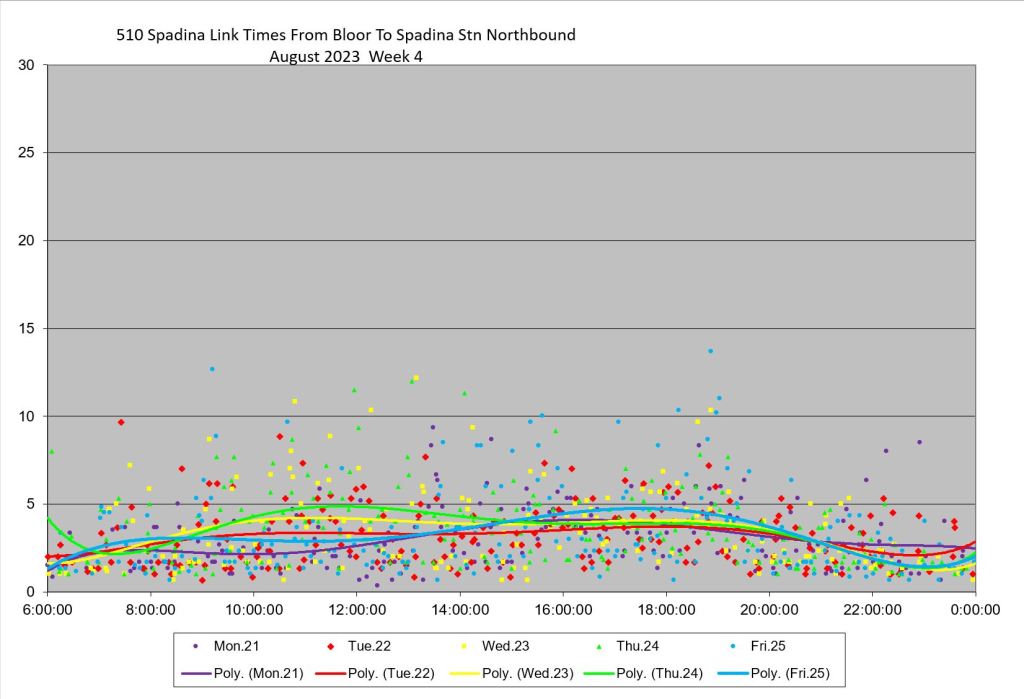
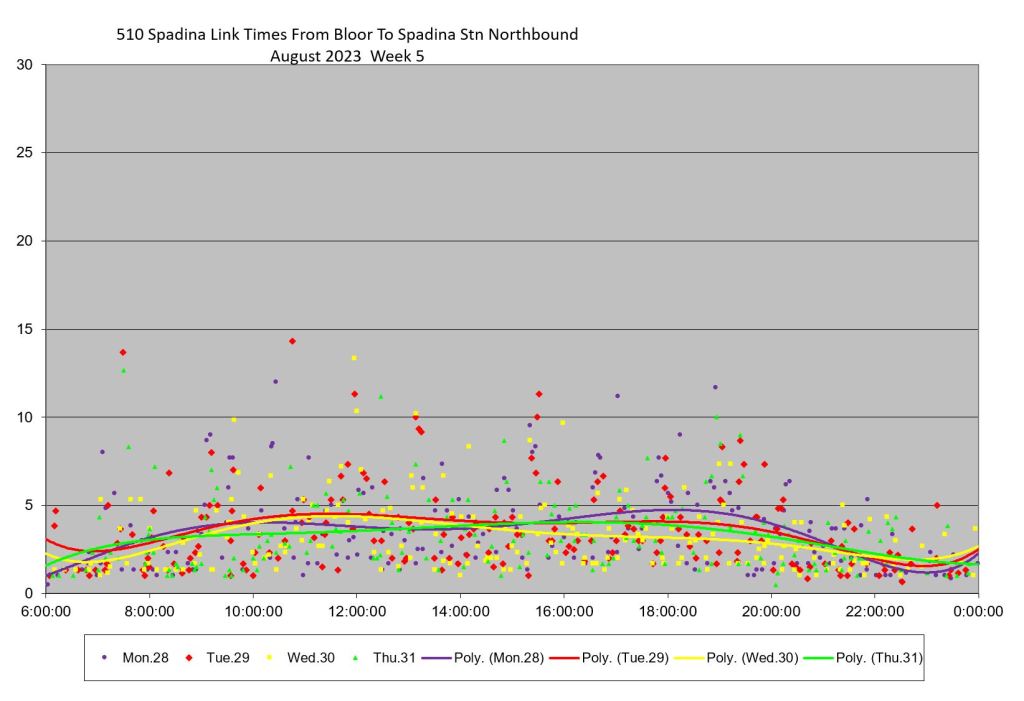
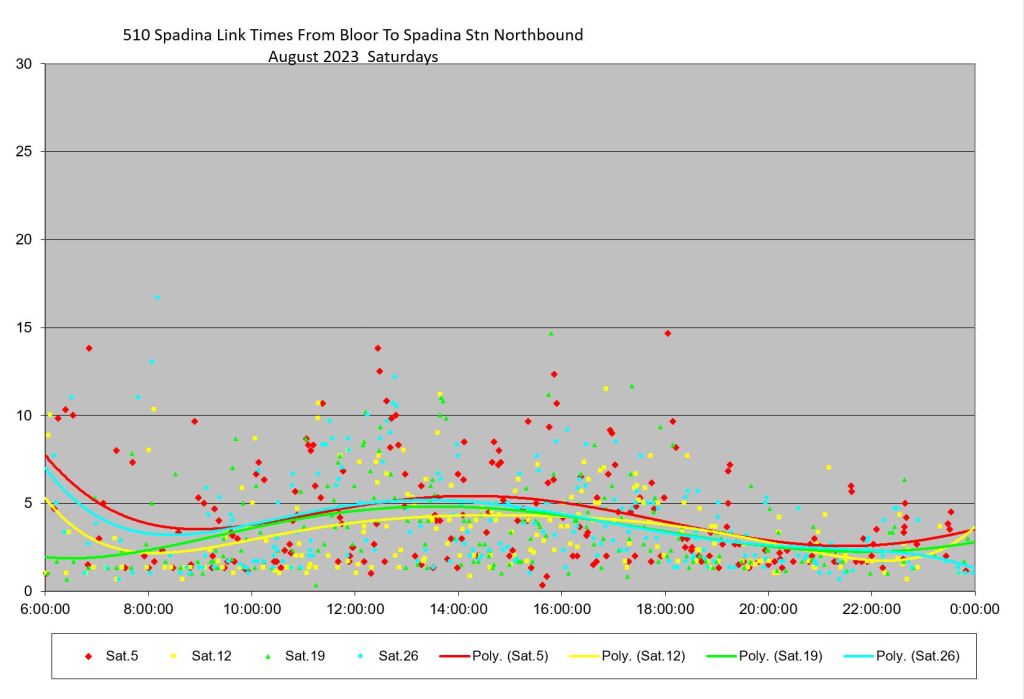
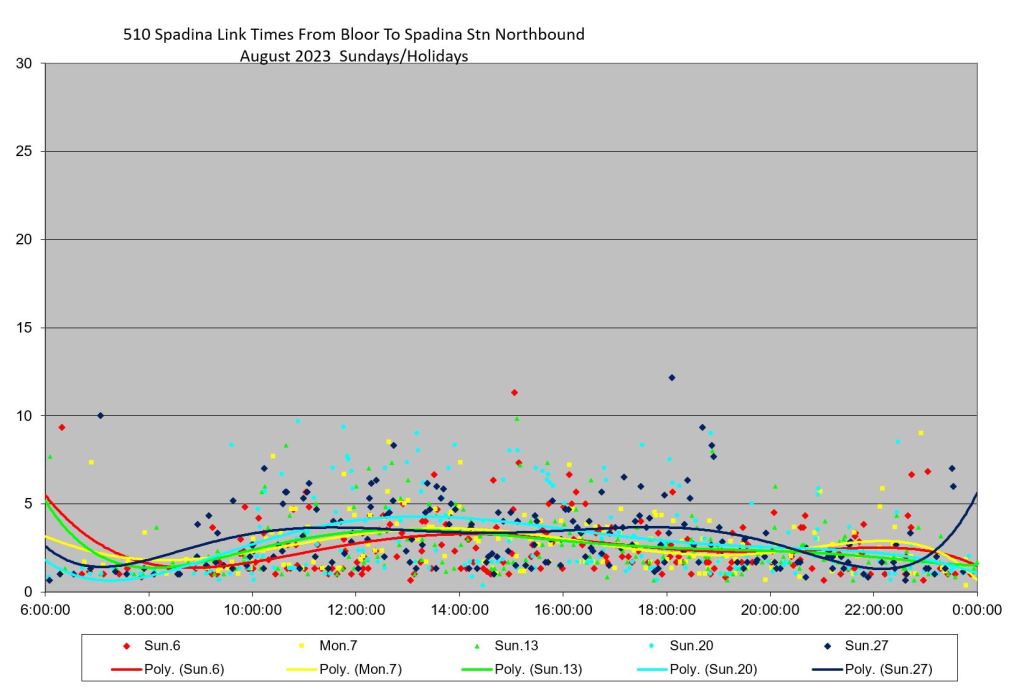
Headways Leaving Spadina Station Southbound
In spite of the tendency for cars to accumulate at Spadina Station, they do not leave regularly spaced. Gaps and bunches are common. Here are charts showing the range of headways leaving the station.
- On weekdays, the averages and the trend lines run consistently at 5 minutes in line with the scheduled service. In other words, all of the planned trips operate, but the data points are scattered either side of the scheduled value.
- The standard deviations in the 2-3 minute range indicate that much of the service lies within a band from 2 to 8 minutes. A six-minute wide band is acceptable in the TTC’s service standards, but this shows just what is the result.
- Some headways lie above the 10 minute line even when they are supposed to average 5 minutes. Correspondingly, there are many headways of 1 or 2 minutes.
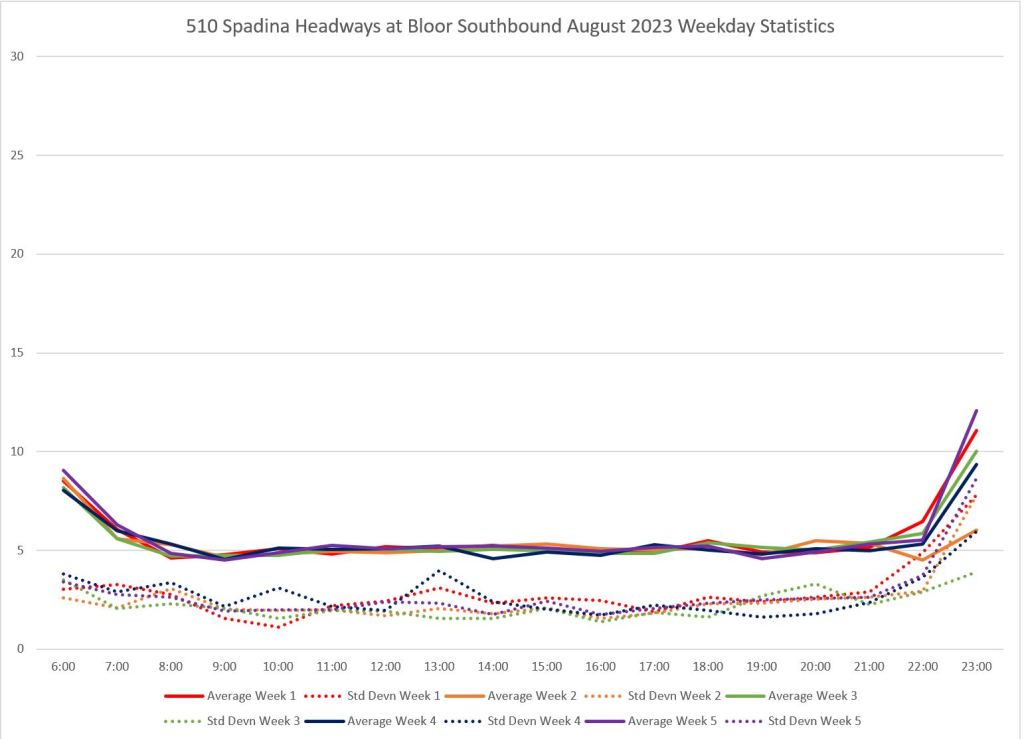
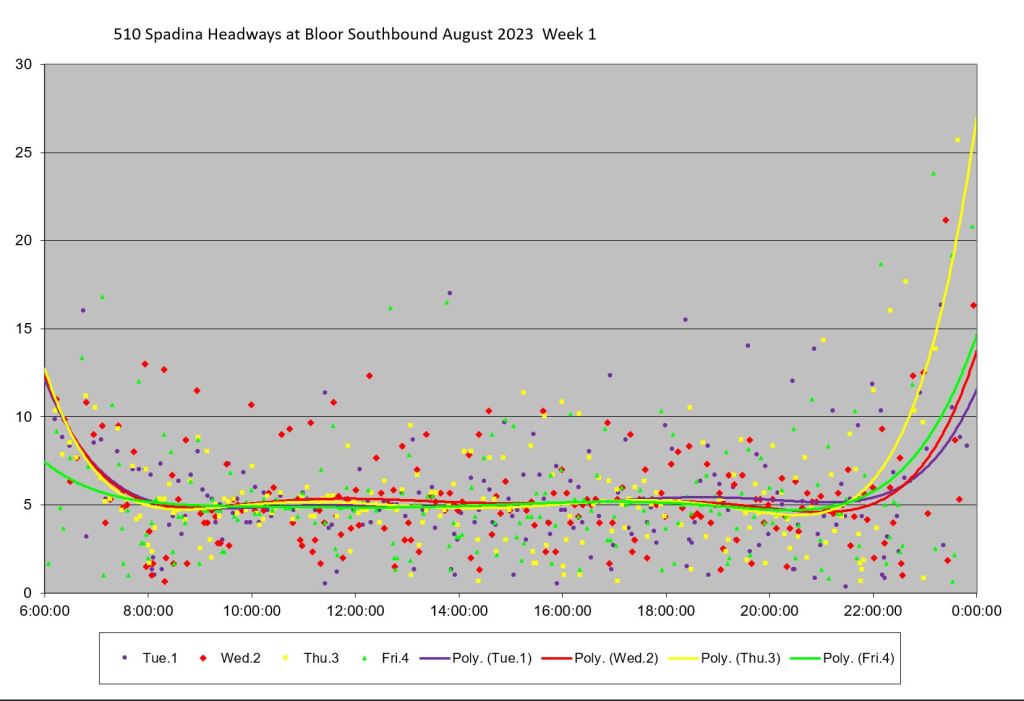
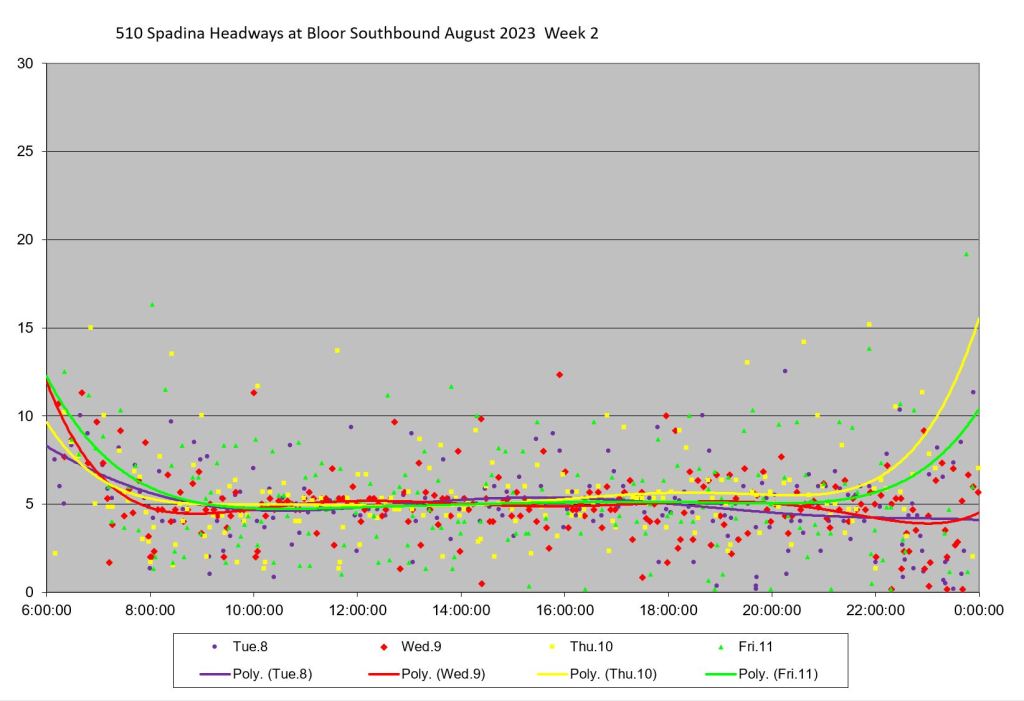
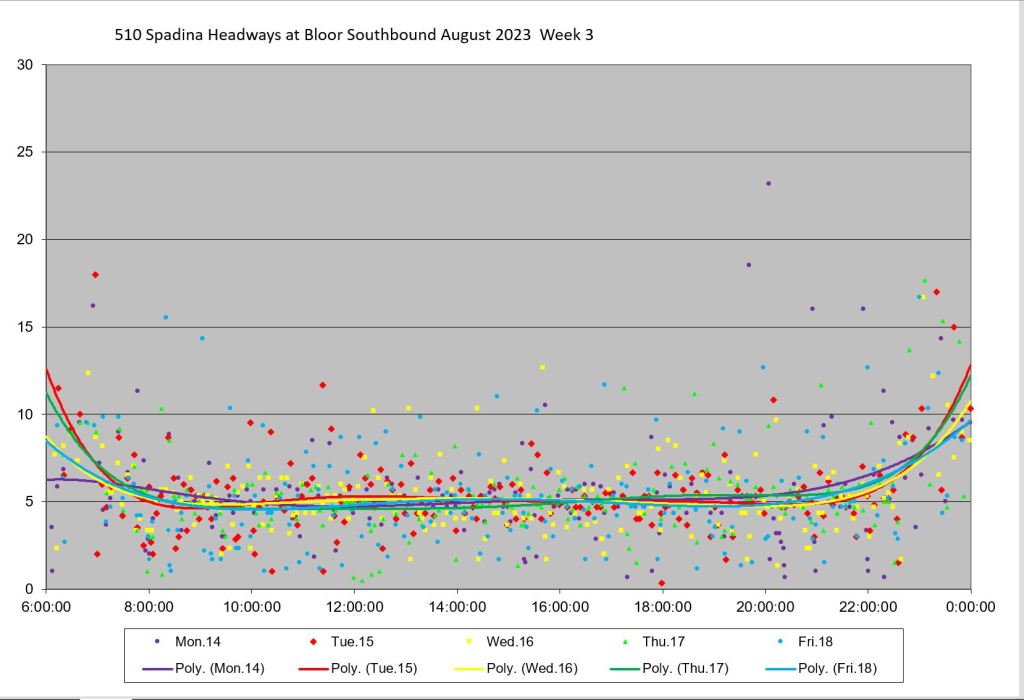
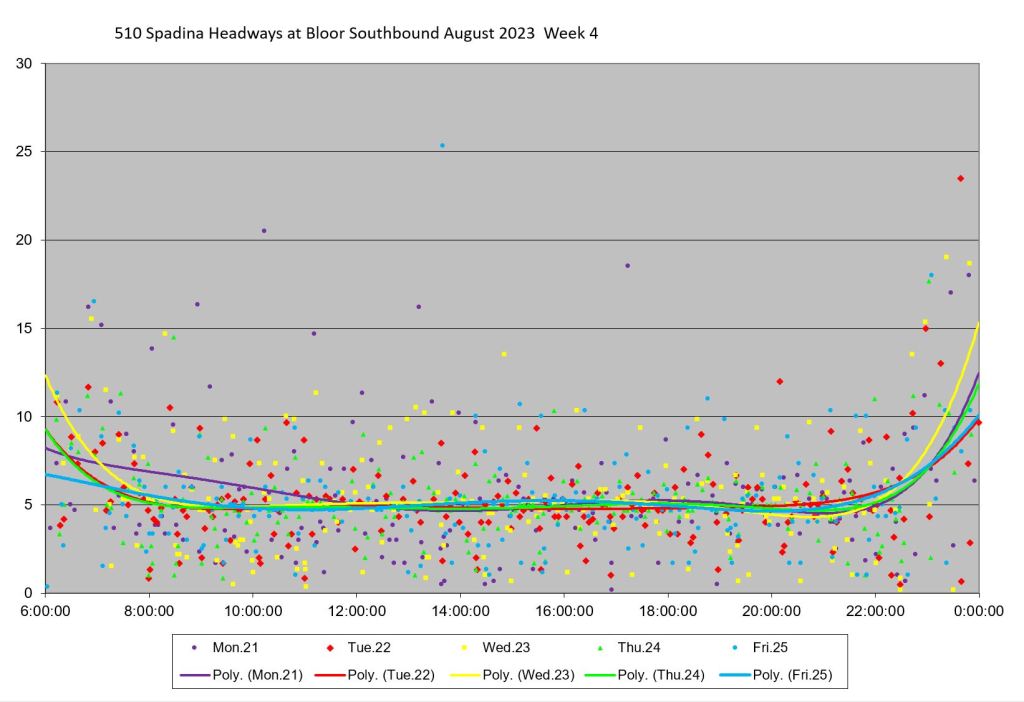
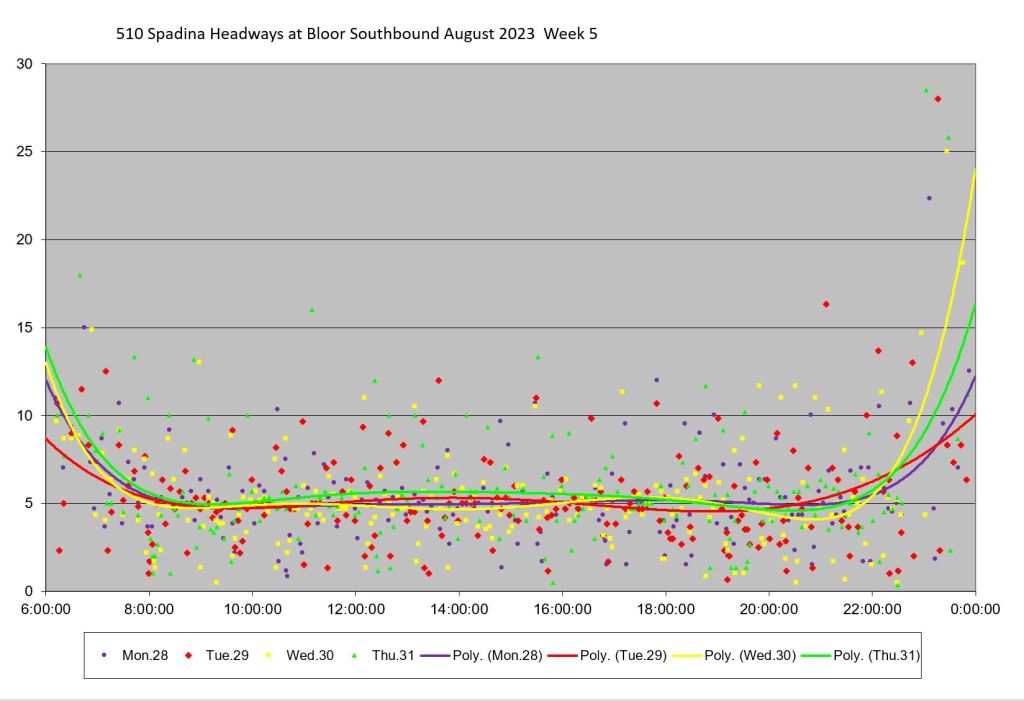
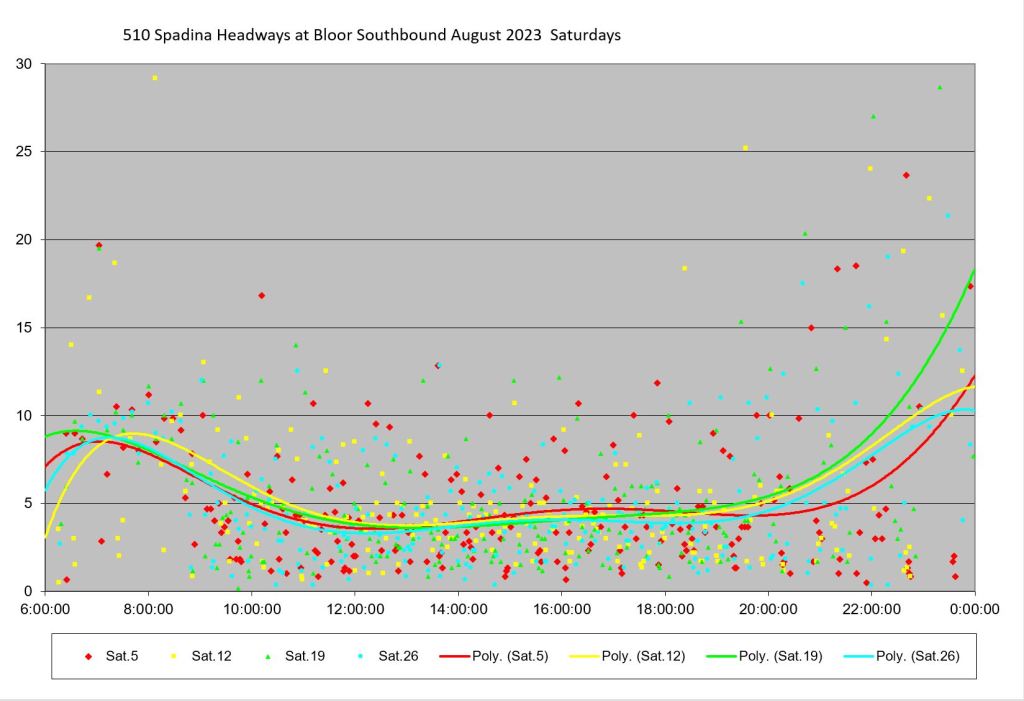
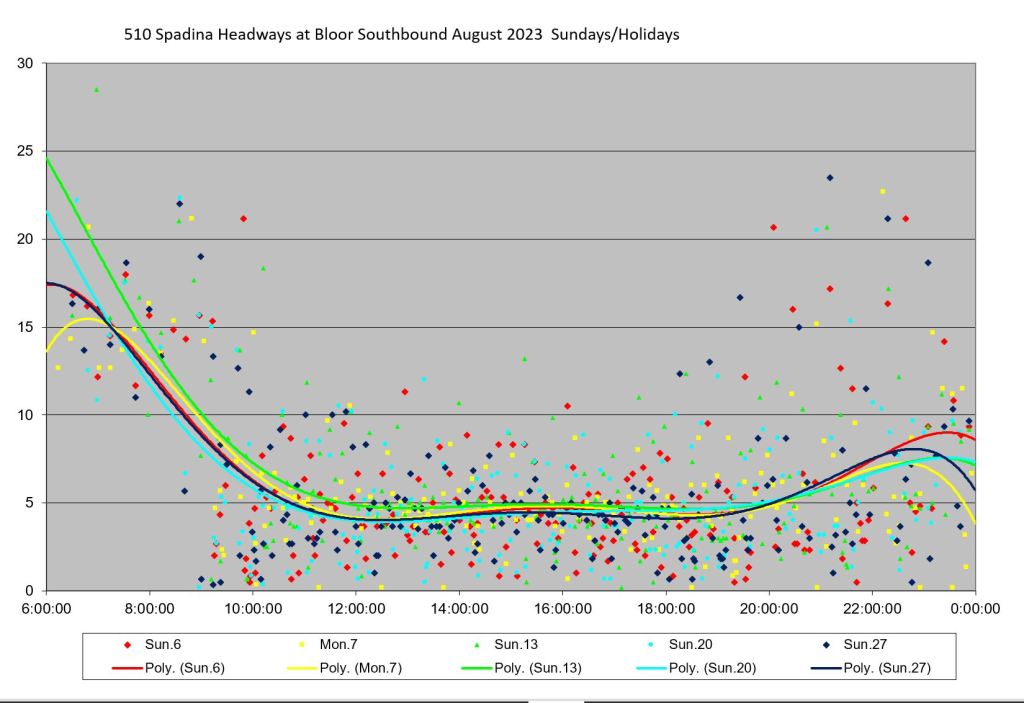

Not to worry. Even if this project were topped up and fully funded I’m sure the local councillor would find a way to derail it at the 11th hour.
LikeLiked by 1 person
Guess there are no funds to rewire the streetcars so each door can be operated on a request basis. They could have started with the 60 new streetcars that are arriving now.
LikeLike
How many segments would have to be taken out of each car to allow two at a time on the platform?
Steve: Only one, but that’s the wrong way of looking at things. The biggest problem is at the west end where there is a structural pillar in the way of extending the platform. If the cars were modified so that doors 2-3-4 could be opened independently of door 1, cars could pull forward to load through those three doors and allow the following car fully into the platform. Changing the door controls is a lot easier than shortening the cars.
LikeLiked by 1 person
As much as I love the Spadina line, this is exactly the reason why I’ve stopped riding it. I’ve been stuck in that tunnel too many times for too long for it to be worth it. On weekends especially, it’s actually a bit faster to walk to the University line and take the subway up to Bloor instead.
LikeLiked by 1 person
In your post, you said that step back crews would be essential to enable vehicles to depart on time. I know the TTC already has experience using such a system on line 1, 3, 4. Why haven’t they done something similar for the streetcar network (if they aren’t already)?
If I had to speculate, it’s probably more efficient and cost effective than modifying the door software or extending the platform.
Steve: I didn’t say it was needed to depart “on time” but rather with a minimal dwell time on the platform because washroom breaks would not hold up the car. They used this trick for a time on Queen East at Russell Carhouse to put operators on time westbound while letting cars (and their passengers) continue through to Neville.
The general challenge for the streetcar network, unlike the subway, is that the step back point has to be convenient to somewhere the operators can take their break. Spadina Station Loop would fit that need, but not many other locations on the streetcar or bus networks.
LikeLike
The Flexitys cannot selectively open doors, except for the very front one, to serve riders while only partly on the platform
This is calling out for a software update to allow more doors to be selectively opened. Seems like one of the cheaper fixes the TTC could make here.
LikeLiked by 1 person
Given the expected work and route changes we will have with the eventual lakeshore east/union station changes…is there an opportunity to build some sort of third track/break area on the eastern part of the route…
Steve: The eastern part of which route?
LikeLike
Steve Said:
“The TTC’s Real Estate Investment Plan includes an item for expansion of the platform at Spadina Station, but it is not clear that this applies to the streetcar platform. With the current tight budget it is hard to see this sitting near the top of the pile for funding.”
To my understanding this investment is for platform expansion and is likely to proceed next year. The work has been advanced to coincide with redevelopment of the entire block south south of Spadina Station (north side of Bloor) by two different developers, who will be excavating around the tunnel/platform structure anyway. Discussions between the proponents and the City/TTC have been held.
Steve: Thanks for the clarification.
LikeLiked by 1 person
There is room to have two streetcars unload and load in spindina, just remove the glass between the structures pillars for door 1 access, that’s the simplest way to solve the problem. I’ve noticed that problem years ago since gradually the new streetcars replacing the CLRV’s , I did do the drawing illustration of the changes that requires simple cosmetic job. .. Union station loop is an problem too , doors 1 and 4 are singles, don’t require too much platform space to extend on each side of platform ….
LikeLike
Dundas West is also having this problem right now with the addition of 506. Back-ups waiting to turn into the station go far enough that streetcars have to wait to even offload at the Bloor St northbound platform at 8pm.
We really need supervisors/dispatchers and step-back crews at the crowded loops in the system – Spadina, Union, Dundas West, probably Broadview, maybe more, there aren’t that many loops.
And yes, selective door operation too. Are there buttons or touchscreen controls in the cab that would allow this, or would we need a hardware retrofit too?
Steve: Yes, a retrofit is needed.
Re Dundas West, I am planning an article on that operation too. It is extraordinarily annoying that there can be both backlogs of cars waiting to get into the loop, and at other times no service at all.
The difference with Spadina is that it isn’t a temporary arrangement.
LikeLiked by 1 person
I heard much the same talk when it came to the southern terminus of this route and the construction of CIBC Square and it all amounted to nothing.
Steve: At Union the problem is that loop expansion is part of a much larger project that is not funded, and which, despite Mayor Tory’s claims of support for the Waterfront LRT, still languishes. I am not holding my breath for much progress when we see how the capital projects are ranked in the 2024 budget.
LikeLiked by 1 person
The order of 60 is an excellent chance to get it rolling! Or was…
Indeed, but dispatchers and step-back crews would help at Dundas West (and elsewhere) beyond the 506 diversion, even though there’s more physical space. When a late streetcar rolls in after a long gap, it can load and depart immediately, rather than operator needing a (well-deserved!) break.
Steve: Yes, definitely.
LikeLiked by 1 person
It seems to me that a lot of the discussion is around capital solutions when the challenges are on the operating side. How hard can it be to do headway management and step back crewing? Certainly easier than rebuilding the entire platform.
LikeLike
This is why we need self-driving vehicles. In advanced countries such as China, Singapore, India, South Korea, Taiwan, and Japan; we have self-driving vehicles driving around even in mixed traffic. Then, why can’t the 510 route here in Toronto with it’s own right-of-way employ self-driving technology? Canada has been outcompeted and it is high time that Canada looks to its more advanced Asian friends for help with building and upgrading the dilapidated infrastructure here in Canada.
Steve: That is a totally bogus claim. The issue is not self-driving vehicles, but bad management and scheduling. Also, I very much doubt there is a comparable service to the Spadina car running on auto pilot anywhere in the world.
LikeLike
In my opinion, the TTC needs to redirect its resources and attention to this issue, and the related issue of the Waterfront LRT. It blows my mind that we’re developing that whole area, with new housing and workspaces, but have zero transit in the pipeline.
Why can’t the TTC get an arrangement with the developers of these new buildings, to either fully or mostly fund these projects. It’s in the developers best interest to see transit infrastructure in place to handle the demands of the what they’re building. The TTC could sell the air-rights above a station, or the city could give rebates on property taxes to developers who bankroll these projects. Or give the developers a break on fees and corporate taxes in order to offset the amount they put into building these critical projects.
Like you said Steve, they will be building right up to the station anyway. Surely its not unreasonable to say ‘if you want to do this you need to fund this upgrade to the station’. If they say no, don’t issue a permit.
At the end of the day the development community needs to see the benefit of good transit infrastructure to the communities they are building. And that the government simply can’t afford to do everything needed to build all this stuff.
These new buildings are a contributing factor to the increase in ridership driving the need to make these changes to the infrastructure. So why does the city not make them pay for part of it or most of it. They could even impose a fee onto the local ratepayers to offset the costs. Like they did for the Scarborough Dumbway Extension. But these things NEED to be done and done yesterday.
Steve: There are two problems with your proposal. First, a portion of the future cost of the Waterfront LRT is already built into Development Charges. The building industry griped about these for years, and Doug Ford has moved to reduce them substantially, not raise them. Second, the expected cost of the Waterfront line substantially exceeds what would be added to the cost of new buildings, and of course it will have a benefit to many others beyond buildings that have not gone up yet. When people gripe about how much DCs add to the cost of a new condo unit, they forget that this is paying for transit projects like the Spadina extension and many others that were funded by Toronto, as well as a lot of infrastructure needed to support a growing city.
By the way, the rules governing how DCs are calculated and assessed were defined by the Province, and the City just followed the formula they set down. But strangely the City gets the blame.
LikeLike
There could be a very short turn possibility if the circle at Spadina Crescent could be fully tracked and switched. The run would unload at Willcocks from Spadina Station and would get the cars out of the subway station. It would serve U of T and Harbord, and College is close by.
Steve: That was in the original plan, but it was removed because of concern that vibration from the switches would affect sensitive lab equipment in a building nearby (Earth Sciences I believe). UofT was rather forceful on that issue.
LikeLike
The most easy, cost-effective solutions, in my opinion (taken from above):
Steve: The yellow light has nothing to do with dispatching. It is simply a cautionary signal like a few others at that loop.
Leaving on a headway rather than “on time” requires a change to crewing rules that, frankly, I think TTC should have investigated long ago, and not just for this route.
Re: Looping around Spadina Circle using new switches:
The closest wing of Earth Sciences complex, formerly the Faculty of Forestry, has been subsumed under the Daniels School of Architecture, Landscape and Design. Someone should talk to them again because I can’t imagine what would be so sensitive to vibration so far away. They have a lot of giant saws for processing wood, and plants being grown in the greenhouses on the roof. Just remind them about the “bangs” from their steam pipes!
Steve: That whole debate dates to an era before the TTC built its track with vibration dampening in the track support. At the time, there were issues with vibration from streetcars on College Street affecting labs along that stretch, and that triggered concern about then-new Earth Sciences building. Spadina’s track is built with rubber sleeves around the rails to dampen vibrations.
Of course, something we have also seen in past decades is vibration isolation within new buildings like TIFF, Koerner Hall and the Four Seasons Centre (Opera House) where theatres are a building-within-a-building mechanically isolated from the surrounding structures. I have been in Tiff cinemas and in Koerner Hall when they were almost empty, and there is no noise from streetcars or subway trains. Anyone designing a vibration-sensitive facility in the middle of the city should take this into account as there are other sources of vibration than streetcars, notably large trucks and the effects of deteriorated pavement.
LikeLike
The loop in Spadina station has a complete circle, and one used to see the occasional CLRV parked between the running tracks. Is that piece of the circle long enough to hold a Flexity – I’d think not. But even if it blocks the outbound track, pulling forward into the circle would surely make enough room for the inbound car to move forward and unload with all doors. A super-short turn, as it were. Or maybe it’s too small a radius for a Flexity…? I guess it would also break various operating rules and maybe has signaling issues to coordinate the movement of two cars. Are those switches entirely manual?
Steve: The easiest move would be to pull forward with the front door slightly beyond the platform and load through the remaining three doors. This would allow a following car to use all doors to unload. The loop is a red herring in tis discussion. I believe it can hold a Flexity, and the switch at its entrance is automatic.
LikeLike
Streetcars were a game changer in the 1800s but streetcars don’t belong in the 21st century. People like Steve want to keep streetcars for nostalgia purposes but you can either satisfy your nostalgia with terrible transit provided by these streetcars or you can replace these streetcars with modern rapid transit.
Steve: Just wondering if you have ever sat in the gigantic queue of trains waiting to get into Kipling or Kennedy terminals in “before times” thanks to bad scheduling. It is possible to cock up a subway line too. As for streetcars, the list of cities still using them and building more lines is quite long.
LikeLike